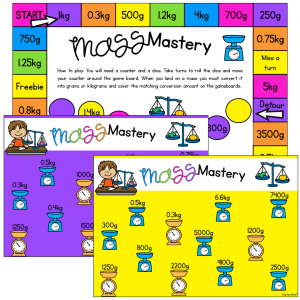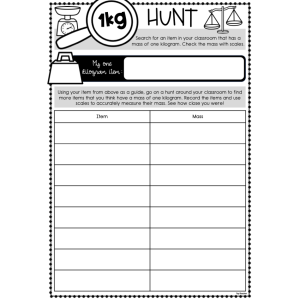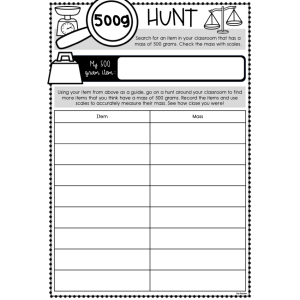Grams & Kilograms Worksheets

Description
Our Grams & Kilograms Worksheets are the perfect tool for helping students build a solid understanding of metric mass conversions. Designed to support your teaching of mass in the upper primary years, this resource focuses on strengthening students’ skills in converting between grams and kilograms while also applying this understanding to comparison and problem-solving tasks.
These worksheets feature a range of engaging, real-world style questions that support students in developing their fluency in metric conversions. Learners will complete activities such as converting between grams and kilograms, calculating how much more is needed to reach 1 kilogram, ordering mass amounts, and applying subtraction and addition within measurement contexts. These tasks are ideal for giving students meaningful practice while developing confidence with the base-10 number system used in metric measurement.
Because these worksheets require students to work with both numerical values and worded questions, they offer an excellent opportunity to integrate numeracy with literacy and promote deeper comprehension of measurement language. Whether you’re introducing, consolidating or assessing your students’ understanding of mass conversions, this resource is a valuable tool to have in your maths toolkit.
Key Learning Outcomes:
- ✅ Convert between grams and kilograms accurately
- ✅ Identify the relationship between 1 kilogram and 1000 grams
- ✅ Calculate the difference between two mass values
- ✅ Order and compare different masses expressed in grams and kilograms
- ✅ Apply measurement skills in solving real-world style problems
What’s Included:
- Multiple printable worksheets focused on grams and kilograms
- Activities involving:
- - Converting between g and kg
- - Finding the difference to reach 1kg
- - Ordering sets of mass values
- - Mixed word problems and practical questions
- Clear layout with a balance of numeric and visual tasks
Materials Needed:
- Printed worksheets (A4 recommended)
- Pencils or coloured pens for working out and checking
- Optional classroom scales or mass benchmarks for extension tasks
How to Use:
- Introduce or revise the concept of 1 kilogram = 1000 grams
- Work through a sample conversion together as a class
- Distribute worksheets and encourage independent or pair-based work
- Use one worksheet as a formative assessment or homework task
- Discuss answers as a class and explore different methods of calculating
Ideas for Classroom Use:
- 💡 Use as part of a maths rotation focused on measurement
- 💡 Provide small mass objects and ask students to estimate and convert their weights
- 💡 Extend fast finishers by asking them to create their own mass word problems
- 💡 Pair with practical activities using scales for real-world reinforcement
Top Teacher Tips:
- 💛 Use visual aids such as labelled benchmark posters to reinforce key conversion facts
- 💛 Review place value regularly to support conversions between grams and kilograms
- 💛 Encourage students to check their conversions using estimation skills first
Grams & Kilograms Worksheets offer purposeful, curriculum-aligned practise to develop your students’ fluency in mass measurement and conversions. Whether used for guided instruction, independent consolidation or assessment, this resource helps bridge the gap between concrete and abstract understanding of mass.
Additional information
| Australian Curriculum Code | AC9M4M01, AC9M5M01, AC9M6M01 |
|---|---|
| File Format |
Australian Curriculum V9
F - 6
Lorem ipsum dolor sit amet, consectetur adipiscing elit.
Lorem ipsum dolor sit amet, consectetur adipiscing elit.
Lorem ipsum/ Lorem ipsum/ Lorem ipsum
Lorem ipsum dolor sit amet, consectetur adipiscing elit.
Lorem ipsum dolor sit amet, consectetur adipiscing elit.
Lorem ipsum/ Lorem ipsum/ Lorem ipsum
Lorem ipsum dolor sit amet, consectetur adipiscing elit.
Lorem ipsum dolor sit amet, consectetur adipiscing elit.
Lorem ipsum/ Lorem ipsum/ Lorem ipsum
Lorem ipsum dolor sit amet, consectetur adipiscing elit.
Lorem ipsum dolor sit amet, consectetur adipiscing elit.
Lorem ipsum/ Lorem ipsum/ Lorem ipsum
Lorem ipsum dolor sit amet, consectetur adipiscing elit.
Lorem ipsum dolor sit amet, consectetur adipiscing elit.
Lorem ipsum/ Lorem ipsum/ Lorem ipsum




